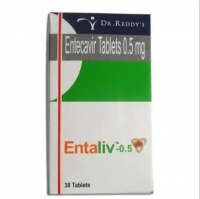Pills triangular shape with concave surface, covered with a film shell is white to almost white, with the engraving "J" on one side and "110" on the other side (for dosage 0.5 mg).
Buy Entecavir Price Entecavir
-
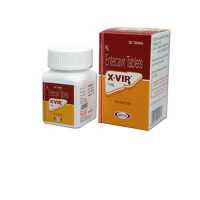 X-VIR 1mg EntecavirIn Stock: много
X-VIR 1mg EntecavirIn Stock: много -
 X-VIR 0.5mg EntecavirIn Stock: много
X-VIR 0.5mg EntecavirIn Stock: много -
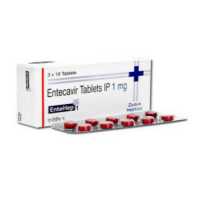 Entehep 1mg EntecavirIn Stock: много
Entehep 1mg EntecavirIn Stock: много -
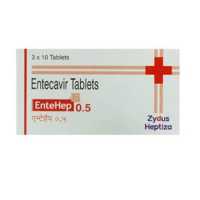 Entehep 0.5mg EntecavirIn Stock: много
Entehep 0.5mg EntecavirIn Stock: много -
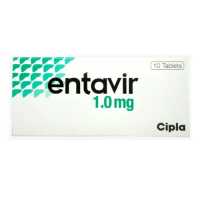 Entavir 1mg EntecavirIn Stock: много
Entavir 1mg EntecavirIn Stock: много -
 Entavir 0.5mg EntecavirIn Stock: много
Entavir 0.5mg EntecavirIn Stock: много -
 Cronivir 0.5mg EntecavirIn Stock: много
Cronivir 0.5mg EntecavirIn Stock: много
Entecavir
Trade name
Entecavir
International nonproprietary name
Entecavir
Dosage form
Pills film coated 0.5 mg and 1 mg
Composition
One tablet contains
active substance – entecavir monohydrate entecavir is equivalent to
0.500 mg or 1,000, respectively,
auxiliary ingredients:calcium carbonate (precipitated) (Sturcal L), pregelatinization starch (Starch 1500 LM), carmellose sodium (Blanose CMC 7LF PH), polysaccharides of soybean (Emcosoy STS IP), citric acid monohydrate (Emprove), sodium fumarate,
composition shell: Opadry II White 13В58802 (dosage 0.5 mg) (HPMC 2910/ Hypromellose 6 CP, titanium dioxide (E 171), macrogol/PEG, Polysorbate 80), Opadry II Pink 03В84566 (dosage 1 mg) (HPMC 2910/ Hypromellose 6 CP, titanium dioxide (E 171), macrogol/PEG, iron oxide red (E172))
Description
Pills triangular shape with concave surface, covered with a film shell is white to almost white, with the engraving "J" on one side and "110" on the other side (for dosage 0.5 mg).
Pills triangular shape with concave surface, covered with a film shell pink, engraved with "J" on one side and "111" on the other side (for dosage 1 mg).
Pharmacotherapeutic group
Antiviral drugs for systemic use. Antiviral drugs direct action. The nucleoside inhibitors reverse transcription-basins. Entecavir.
Code ATX J05AF10
Pharmacological properties
Pharmacokinetics
Absorption. After oral administration, the entecavir is rapidly absorbed, Cmax in the blood plasma determined by 0.5–1.5 h. the Absolute bioavailability has not been determined. Based on the results of excretion, the bioavailability is at least 70%. When multiple receiving entecavir at a dose of from 0.1 to 1 mg marked increase in Cmax and AUC proportional to increase in dose. Equilibrium is achieved after 6-10 days intake 1 time per day, this plasma concentration increases approximately 2 times. Cmax and SMP in plasma at steady state were, respectively, 4.2 and 0.3 ng/ml when taking 0.5 mg; 8.2 and 0.5 ng/ml to 1 mg. When administered entecavir at a dose of 0.5 mg food with highest fat and low, there has been a slight delay suction (1-1.5 hours — when taken with a meal and a 0.75 h — when taken on an empty stomach), reduced C Max to 44-46% and decrease AUC by 18-20%.
Distribution. The estimated volume of distribution for entecavir exceeded the total volume of water in the body, which indicates a good penetration of the drug in tissue. The relationship of entecavir with proteins of the person in vitro is around 13 %.
Metabolism and excretion. Entecavir is not a substrate, inhibitor or inducer enzymes of the CYP450 system. After the introduction of labeled 14C-entecavir humans and rats have not been determined oxidized or atsetilirovannye metabolites and phase II metabolites (glucuronide and sulfates) were determined in small quantities.
After the maximum level is reached, the concentration of entecavir in plasma bieksponencialno decreased, while T1/2 was 128-149 h. When taken 1 time per day was the increase in the concentration of the drug in 2 times (cumulative), that is effective T1/2 approximately 24 hours
Entecavir excreted mainly by the kidneys, and in equilibrium in unchanged in the urine is 62-73% of the dose. Renal clearance is not dependent on the dose and ranges from 360 to 471 ml/min, which is indicative of glomerular filtration and tubular secretion of the drug.
Special population
Floor and race
Pharmacokinetics entecavir is the same in patients, male and female and among racial groups.
Elderly
Have elderly patients the area under the curve (AUC) of entecavir has a tendency to increase (29.3 % more) in comparison with people at a young age. This increase is likely to be associated with with renal dysfunction and reduced body mass, so you need correction of the dose.
Renal failure
Pharmacokinetic properties of entecavir following a single oral 1 mg of the drug been studied in patients (without chronic hepatitis b infection) selected degrees of renal disorders - including patients, hemodialysis or chronic ambulatory peritonealna dialysis (GAPD). Studies have shown reduced clearance of the drug, occurs when a reduction in creatinine clearance. After a single receiving 1 mg entecavir 2 hours before hemodialysis, by this procedure removed approximately 13 % of the entecavir after 4 hours. HAPD, removed approximately 0.3% of the dose after 7 days. Entecavir should be taken after hemodialysis.
Violation liver function
Pharmacokinetic properties similar to entecavir in patients with impaired liver function and in healthy people; therefore for these patients dose adjustment is not is considered necessary.
After liver transplant
Efficiency and safety of entecavir in the appointment of persons who have had liver transplantation has not been established. However, in the course of a small pilot study on the appointment of entecavir HBV-infected recipients of liver transplants, the host cyclosporine a (n = 5) or Makrolon (n = 4) in stable doses, entecavir exposure was approximately 2 times greater than in healthy patients with normal liver function. Change liver function contributed to improving the exposition entecavir in these patients. The potential for pharmacokineticinteractions between entecavir and cyclosporine A or tacrolimus not formally assessed. Before taking entecavir recipients a transplant of the liver, taking or receivingimmunosuppressant that can affect liver function – cyclosporine, tackroom – and also during the reception, liver function should be monitored carefully.
Pharmacodynamics
Entecavir is a nucleoside analogue of guanosine with potent and selective activity against HBV polymerase. Entecavir fosfauriliruetsa with the formation of the active triphosphate (TF), which has a half-life 15 hours. The intracellular concentration of TF is directly related to extracellular levels of entecavir, and not significant accumulation of the drug after entry-level "plateau". By competition with the natural substrate, deoxyguanosine-TF, entecavir-TF inhibits all 3 functional activity of virus polymerase: (1) priming and polymerase of hepatitis b virus, (2) reverse the transcription of negative strands of RNA pregenome and (3) synthesis the positive DNA strand of the virus of hepatitis B. entecavir Ki-TF polymerase hepatitis b virus is 0.0012 µm. Entecavir TF is weak inhibitor of cellular DNA polymerases α, β and δ with Ki 18-40 microns. In addition, at high concentrations entecavir entecavir and TF are not noted side effects in terms of γ polymerase and DNA synthesis in the mitochondria of HepG2 cells.
Indications for use
- Chronic hepatitis b In adults with:
- compensated liver disease and viral replication the increased activity of serum transaminases (ALT or ACT) and histological signs of inflammation in the liver and/or fibrosis
- decompensated liver
Appointment for the compensated and the decompensated types of liver damage based on data from clinical trials conducted on not taking nucleosides patients with positive HBeAg and for HBeAg negative HBV infection, including patients with lamivudine-resistant hepatitis B.
Method of application and doses
Welcome of the drug the patient is allowed under the guidance of doctors with experience in the treatment of hepatitis B.
Entecavir taken orally, on an empty stomach (i.e. at least 2 hours after a meal and not later than 2 hours before the next meal).
Have patients with compensated liver the recommended dose of entecavir is 0.5 mg of 1 times a day. Lamivudine-resistant patients (i.e., patients with viremia hepatitis b virus persisting during therapy with lamivudine in history or patients with confirmed resistance to lamivudine) appoint 1 mg entecavir 1 time a day.
Duration treatment
Optimal the duration of treatment is unknown. Stopping treatment can consider the following:
• adult patients with HBeAg positive treatment should be carried out for at least 12 months after achieving HBe seroconversion (HBeAg loss and HBV DNA loss with the determination of anti-HBe in two consecutive serum samples at least 3-6 months each from one another) or until HBs seroconversion or if there is loss efficiency
• adult patients with HBeAg negative, treatment should continue until HBs seroconversion or until the establishment of the loss efficiency. With prolonged treatment for more than 2 years is recommended regular reassessment to confirm that the continuation selected treatment remains appropriate for the patient.
Patients with decompensated liver appoint 1 mg entecavir once daily. For patients with decompensated liver disease or cirrhosis liver to stop treatment is not recommended.
Elderly patients. Dose adjustment for this group of patients is not required. The dose should to be adjusted in accordance with renal dysfunction patient.
Patients with renal insufficiency. Clearance of entecavir decreases with decreasing creatinine Cl. It is recommended that dose adjustment of entecavir patients with creatinine Cl <50ml/min, including hemodialysis and prolonged outpatient peritoneal dialysis, according to the table.
Table
Recommended the dose of entecavir in patients with renal insufficiency
|
Cl creatinine, ml/min |
Patients have not previously received a nucleoside analog drugs |
Resistant to lamivu-DIN patients and patients with decomposi-specific lesion liver |
|
≥50 |
0.5 mg 1 time per day |
1 mg 1 time per day |
|
30-49 |
0.5 mg every 48 hours |
0.5 mg 1 time per day |
|
10-29 |
0.5 mg every 72 h |
0.5 mg every 48 hours |
|
<10 Hemodialysis* or long-term ambulatory peritoneal dialysis |
0.5 mg every 5-7 days |
0.5 mg every 72 hours |
* Entecavir should be taken after hemodialysis.
Have patients with hepatic insufficiency dosage adjustment of Entecavir is not required.
Side effects
Often (≥ 1/100 to <1/10)
- insomnia
- headache, dizziness, drowsiness, fatigue
- vomiting, diarrhea, nausea, dyspepsia, abdominal pain, sudden the weight loss
- shortness of breath, rapid breathing, muscle weakness
- elevation of transaminases
- the decrease in the concentration of bicarbonate in the blood, increased ALT and the concentration of bilirubin more than 2 times compared with CAH, the concentration of albumin less than 2.5 g/DL, the increase in the activity of lipase more than 3 times compared with the norm, concentration of platelets below 50000/mm3, increasing the concentration of amylase lipase
Infrequently (≥ 1/1000 to <1/100)
- rash, alopecia
Rarely (≥ 1/10000 to <1/1000)
- lactic acidosis
- anaphylactoid reaction
- renal failure
Contraindications
-
increased sensitivity to entecavir or any of the subsidiary components of the drug
-
pregnancy and lactation
-
children and adolescence to 18 years
Drug interactions
Metabolism entecavir was investigated in vitro and in vivo. Entecavir is not is a substrate, inhibitor or activator of cytochrome P450 (CYP450). At concentrations approximately 10,000 times greater than concentrations observed in humans, entecavir inhibited none of the the main CYP450 enzymes: 1A2, 2C9, 2C19, 2D6, 3A4, 2B6, and 2E1. When concentrations, about 340 times higher than the concentration observed in humans, entecavir inhibited the activity of enzymes CYP450 in humans: 1A2, 2C9, 2C19, 3A4, and 2B6 3А5.Pharmacokinetic properties of entecavir with a small probability at the same time influenced by the drugs taken, which metabolized by CYP450 system to inhibit or activate it. Similarly, the pharmacokinetics of known CYP substrates with a small probability is exposed to while receiving entecavir.
Since entecavir is excreted primarily by the kidneys, while the introduction of drugs that reduce renal function or compete on the the level of tubular secretion may increase concentrations in plasma entecavir or these drugs. Simultaneous the appointment of entecavir with lamivudine, adefovir or tenofovir is not identified significant drug interactions. Interaction entecavir with other drugs that are excreted by the kidneys or affect on renal function have not been studied.
Special instructions
Relapses hepatitis
When chronic hepatitis is quite common to happen sudden exacerbation, which is characterized by the ongoing increase in ALT. After the start of antiviral therapy, the ALT levels may increase in some patients, while the levels of HBV DNA in serum blood reduced. Aggravation, on average, start on the 4-5-th week. In patients with compensated liver disease or increased ALT serum, as a rule, not accompanied by an increase in the concentration of bilirubin in serum or liver the decompensation. Should conduct close clinical and laboratory monitoring during treatment for patients with advanced liver disease or cirrhosis, as these patients are at higher risk hepatic decompensation with exacerbation of hepatitis.
Have patients who terminated the treatment of hepatitis b, including the reception Entecavir have also been cases of serious acute relapse of hepatitis B. Exacerbation after treatment, usually associated with rising HBV DNA, including cases with a fatal outcome. On average, exacerbation starts patients not previously receiving nucleoside drugs, 23-24-s weeks after the end of drug therapy Entecavir. Most of them were registered in patients with negative HBeAg. Liver function should be monitored in for equal intervals of time in clinical andlaboratory observations for at least 6 months after the end of treatment of hepatitis.
Patients with decompensated liver disease
More the high rate of serious adverse events (whatever the reason) observed in patients with decompensated liver disease, in particular class on the scale of child-Turcott-Drink compared to indicators in patients with compensated liver disease. These patients are at greater risk of lactic acidosis and adverse reactions, such as hepatorenal syndrome, so must carefully monitor clinical and laboratory the indicators in this population.
Lactic acidosis and severe hepatomegaly with steatosis
When treatment with nucleoside analogues as monotherapy and in combination with antiretroviral drugs described cases of lactic acidosis and severe hepatomegaly with steatosis, leading sometimes to death patient. As entecavir is a nucleoside analogue, this risk should not be excluded. Treatment with nucleoside analogues should to stop in the event of a rapid increase in aminotransferase levels, progressive hepatomegaly or metabolic/lactic acidosis of unknown etiology. Such reactions from the digestive system as nausea, vomiting and abdominal pain, may indicate on the development of lactic acidosis. Severe cases, sometimes fatal outcome, were associated with pancreatitis, liver failure/hepatic steatosis, renal failure and more high levels of serum lactate. When you assign a nucleoside analog analogues patients with hepatomegaly, hepatitis or other known risk factors for diseases of the liver, should be the caution (especially in women with obesity). For these patients need to keep a careful medical supervision.
Doctors must ensure that changes in ALT are associated with improvements in other laboratory markers of chronic hepatitis b due to a response treatment, not with possible lactic acidosis.
Resistance and special precautions for patients not responding to treatment lamivudine
Mutations in the HBV polymerase that encode lamivudine-resistant substitutions can lead to the subsequent emergence of secondary substitutions, including those associated with entecavir resistance (ETVr). A small percentage of patients not amenable to treatment with lamivudine, ETVr substitutions at residues rtT184, rtS202 or rtM250 were present in original condition. Patients with HBV have lamivudineresistant more high risk of developing subsequent Entecavir resistance than patients not resistant to lamivudine. The cumulative probability emerging genotypic entecavir resistance after 1, 2, 3, 4 and 5 years of treatment in lamivudine-resistant studies was 6%, 15%, 36%, 47% and 51%, respectively. Have lamivudine-resistant groups should frequently monitor virologic response and perform the necessary testing for resistance. In patients with suboptimal virological response after 24 weeks of treatment the entecavir should reconsider treatment. Starting treatment patients with a documented history of lamivudine resistance in HBV, should be considered the treatment with the drug containing only entecavir, is a combination of entecavir with the second antiviral drug (which does not share cross resistance with either lamivudine or entecavir). Earlier existing lamivudine-resistance in HBV is characterized by increased risk of resistance to entecavir, regardless of the degree of liver disease. In patients withdecompensated liver disease, virologic breakthrough may to be associated with serious clinical complications of the disease liver. Thus, patients with decompensated disease liver and lamivudine-cennostey with HBV, should be preferred give drug therapy containing only entecavir and not the combined use of entecavir with a second antiviral the drug (which does not share cross-resistance with either lamivudine or entecavir).
Confezione hepatitis C, or D
No data on the efficacy of entecavir in patients coinfected with With hepatitis C or D.
Simultaneous HIV infection
Impact Entecavir in patients infected with both HIV and the virus hepatitis b is not undergoing simultaneous effective treatment for HIV, has not been studied.
Limited clinical experience suggests the possible development of resistance to nucleotide reverse transcriptase inhibitors of the virus human immunodeficiency (HIV), if Entecavir is used if viral hepatitis infection In patients with HIV infection previously not receiving treatment for HIV infection. Treatment the entecavir should not be used for HIV/HBV coinfectedpatients not receiving highly active retroviral therapy. No data on the effectiveness entecavir in patients coinfected with HIV with a negative HBeAg. There are quite limited information about coinfected with HIV patients with low the number of CD4 cells (< 200 cells/mm3).
Entecavir not been studied as a drug for the treatment of HIV infection.
Patients with renal insufficiency
Patients whose creatinine clearance is < 50 ml/min, including hemodialysis or HAPD, it is recommended that the drug with caution and based on individual tolerance and efficiency.
Patients undergoing a liver transplant
Security and efficacy of entecavir in patients undergoing transplantation the liver is unknown. You should carefully monitor renal function before and during treatment with entecavir in patients undergoing liver transplantation who are receiving immunosuppressants, which may affect renal function, such as cyclosporine and tacrolimus.
Information for patients
Patients should be under medical supervision while taking Entecavir; any new symptoms or drugs nominated for simultaneous receipt in order to discuss with your doctor. Patients should be informed that in some cases, discontinuation of the drug may cause dysfunction of liver. The regimen of the drug should be changed under the guidance of a doctor.
To initiation of therapy with Entecavir, patients should offer to take the test for HIV-antibodies. Patients should be informed about what if they are HIV-positive and do not pass effective HIV treatment, entecavir may increase the resistance ARV medicines for HIV treatment.
Patients it is also necessary to inform that the treatment with Entecavir, the risk transmission of HIV to others through sexual contact or infected blood is not reduced. It is therefore necessary to take adequate protection measures.
Lactose
Contraindicated individuals with hereditary fructose intolerance, enzyme deficiency Lapp-lactase malabsorption of glucose-galactose.
Pregnancy and lactation
Data on the use of entecavir in pregnant women are lacking. Animal studies have shown reproductive toxicity at large doses. The potential risk for humans is unknown. Entecavir do not use during pregnancy. Data on the impact entecavir on transmission of hepatitis b virus from mother to infant baby missing. Thus needs to be taken appropriate measures to prevent neonatal acquisition the virus of hepatitis B.
In the time course of treatment with entecavir breast-feeding should be discontinued. Given that the potential the risks to the developing fetus are unknown, women of childbearing age should use effective contraception.
Fertility
Toxicological studies on animals who were administered entecavir, no demonstrated fertility.
Application in elderly patients
In clinical studies of Entecavir, the number of patients in age 65 and above were not sufficient to determine different effect of the drug in these patients from the effect of his more young patients. Entecavir is excreted from the body primarily through the kidneys, and the risk of toxic reactions to this drug may be greater in patients with impaired renal function. Because of the high probability renal failure in elderly patients, it is necessary to observe caution in the selection of doses and monitoring of renal function.
Features the influence of the drug on the ability to drive a vehicle or potentially dangerous machinery Patients should be warned about the possible appearance during treatment drug Entecavir fatigue, dizziness, fainting, orthostatic/postural hypotension, visual disorders and other adverse events that may affect the ability to operate a vehicle. If you experience these symptoms patients are advised to refrain from driving and occupation of other potentially hazardous activities that require high concentration and psychomotor speed reactions.
Overdose
Symptoms: increased side effects.
Treatment: in case of overdose should monitor vital functions of the patient and if necessary carry out standard supporting therapy.
Shape of release and packing
Pills film coated 0.5 mg and 1 mg.
At 30 or 90 tablets placed in a plastic container high density.
At 1 container along with instructions for medical use in the state and Russian languages is placed in a cardboard pack.
Storage conditions
Store in a dry, protected from light place, at temperature not above 25 S.
Store in unavailable of children!
Shelf life
1.5 year.
Not use after expiration date.

